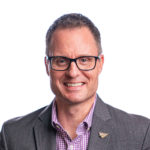sponsored content
August 29, 2019
By Ryan Parker, OD
Director of Professional Development for Essilor of America
 Since Essilor launched its Myopia Matters campaign earlier this year, I have been working on two goals: First, raising awareness among eye care professionals (ECPs) about the importance of treating myopia early to avoid eye health issues later in life. And second, making educational resources available to help practitioners improve their myopia management skills.
Since Essilor launched its Myopia Matters campaign earlier this year, I have been working on two goals: First, raising awareness among eye care professionals (ECPs) about the importance of treating myopia early to avoid eye health issues later in life. And second, making educational resources available to help practitioners improve their myopia management skills.
There is much work to be done, but we are making progress. The truth is that many optometrists are still working under the lessons they were taught in optometry school years ago. Many ECPs, when treating a myope, simply prescribe a new pair of single vision glasses. That’s not good enough, because single vision spectacles do not affect slowing the progression of myopia.
By 2050, an estimated 5 billion people around the world will be myopic, according to a 2016 study by the Brien Holden Vision Institute. In the United States, 42 percent will be myopic by 2020, compared to just 28 percent in 2000, according to the study. Furthermore, myopia is not a benign refractive condition. The research is overwhelming that if children have even moderate myopia, it can lead to eye health problems later in life, such as retinal detachment, myopic macular degeneration, PSC cataracts, and open-angle glaucoma. There is no safe level of myopia.
Here’s what’s baffling when talking with ECPs about myopia. I talk about glaucoma and how much change has occurred in glaucoma care and get no pushback from ECPs. However, when I talk about changes in how myopia should be managed, there is more resistance. That is why raising awareness of the long-term eye health issues associated with myopia is such a vital part of this effort.
In a perfect world, I’d like every optometrist out there to know what to look for in patients who are high risk and treat them or refer them out to an ECP who will take steps to slow the progression of myopia. When I talk to eye care professionals, I say, “You don’t have to change your approach to managing myopia completely. However, if you don’t, refer those patients to an optometrist who has.”
Diagnosing myopia is relatively simple. What is tougher to determine is which myopia management options to prescribe for an individual child because there are many aspects to consider. I’m glad my colleagues in optometry are giving this problem more attention, and I think that in the next two to three years we’re going to see many more options for eye doctors to become experts in myopia management. They’re increasingly ready to learn. I don’t think we’re far away from where we’re going to get enough data where the standard of care is going to change.
Part of my work with Essilor is helping to train our sales consultants on myopia and different treatment options. There’s always one person in the audience, a high myope, who will ask, “What can I do?” Unfortunately, I have to say, “There’s nothing you can do now to reduce your prescription, but if we’d been able to treat you when you were six or seven or eight, we could have changed this.” Then, when they go out in the field, that personal story is compelling.
I don’t want to be in a profession that is reactive to the myopia epidemic. We should be at the forefront. We should embrace new technology and new ways to manage myopia. OCTs, for example, used to be considered new technology and now that technology is regarded as a standard of care for managing glaucoma and various retinal conditions.
If we don’t improve the quality of our myopia care, the comorbidities associated with myopia will create a public health crisis in the U.S. Together, we can slow the progression of myopia.

Ryan Parker, OD, is director of professional development for Essilor of America.













